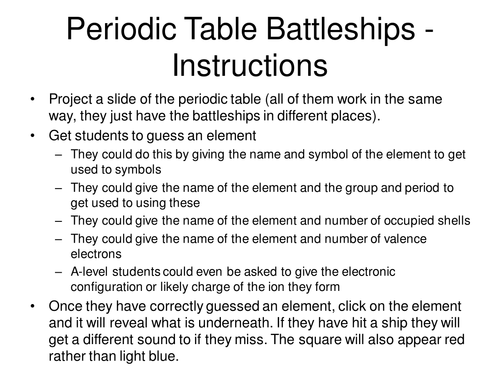

Excellent resource for teaching anything related to elements or the Periodic Table. Students can learn the symbols for elements by guessing the names of elements in order to try and find the battleships underneath. You can also use it to get students using groups and periods to guess the elements. You might even ask them to tell you how many occupied shells and element has, how many valence electrons it has, an elements likely charge as an ion or even its electron configuration (in terms of orbitals with A-level students).
Very simple to use. Make sure your speakers are on and simply start the slideshow. Students select the square they would like to aim at by giving you the piece of information you want e.g. sodium, Na or sodium group 1 period 3 or sodium +1 etc, you click on the element they selected and find out whether they have hit one of the 3 ships. There are extra slides so you can play multiple times or you could easily modify one of the slides to make your own alternative positions/ships/games.
Suitable with
KS3 - elements
KS4 - all specifications - structure of the periodic table
KS5 - all specifications - electron configuarations, charges of ions, common oxidation states.
Possible learning outcomes:
Describe the structure of the periodic table.
Recall the symbols of the first 20 elements.
Describe an element's position in the table using groups and periods.
Deduce the number of valence electrons an element has from its position in the periodic table.
Deduce the number of occupied shells an element has from its position in the periodic table.
Very simple to use. Make sure your speakers are on and simply start the slideshow. Students select the square they would like to aim at by giving you the piece of information you want e.g. sodium, Na or sodium group 1 period 3 or sodium +1 etc, you click on the element they selected and find out whether they have hit one of the 3 ships. There are extra slides so you can play multiple times or you could easily modify one of the slides to make your own alternative positions/ships/games.
Suitable with
KS3 - elements
KS4 - all specifications - structure of the periodic table
KS5 - all specifications - electron configuarations, charges of ions, common oxidation states.
Possible learning outcomes:
Describe the structure of the periodic table.
Recall the symbols of the first 20 elements.
Describe an element's position in the table using groups and periods.
Deduce the number of valence electrons an element has from its position in the periodic table.
Deduce the number of occupied shells an element has from its position in the periodic table.
Something went wrong, please try again later.
This resource hasn't been reviewed yet
To ensure quality for our reviews, only customers who have purchased this resource can review it
Report this resourceto let us know if it violates our terms and conditions.
Our customer service team will review your report and will be in touch.
£2.00